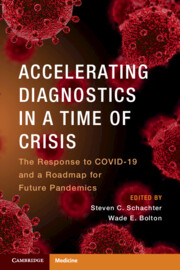52 results
Index
-
- Book:
- Accelerating Diagnostics in a Time of Crisis
- Published online:
- 06 January 2024
- Print publication:
- 07 March 2024, pp 274-280
-
- Chapter
- Export citation
Acknowledgments
-
- Book:
- Accelerating Diagnostics in a Time of Crisis
- Published online:
- 06 January 2024
- Print publication:
- 07 March 2024, pp xvii-xx
-
- Chapter
- Export citation
Chapter 4 - Contribution of RADx® Tech to the Rapid Development of COVID-19 Diagnostic Tests
-
-
- Book:
- Accelerating Diagnostics in a Time of Crisis
- Published online:
- 06 January 2024
- Print publication:
- 07 March 2024, pp 74-87
-
- Chapter
- Export citation
Contributors
-
- Book:
- Accelerating Diagnostics in a Time of Crisis
- Published online:
- 06 January 2024
- Print publication:
- 07 March 2024, pp ix-xii
-
- Chapter
- Export citation
Chapter 14 - Summary and Path Forward for Future Pandemics
-
-
- Book:
- Accelerating Diagnostics in a Time of Crisis
- Published online:
- 06 January 2024
- Print publication:
- 07 March 2024, pp 263-273
-
- Chapter
- Export citation
Dedication
-
- Book:
- Accelerating Diagnostics in a Time of Crisis
- Published online:
- 06 January 2024
- Print publication:
- 07 March 2024, pp v-vi
-
- Chapter
- Export citation
Copyright page
-
- Book:
- Accelerating Diagnostics in a Time of Crisis
- Published online:
- 06 January 2024
- Print publication:
- 07 March 2024, pp iv-iv
-
- Chapter
- Export citation
Contents
-
- Book:
- Accelerating Diagnostics in a Time of Crisis
- Published online:
- 06 January 2024
- Print publication:
- 07 March 2024, pp vii-viii
-
- Chapter
- Export citation

Accelerating Diagnostics in a Time of Crisis
- The Response to COVID-19 and a Roadmap for Future Pandemics
-
- Published online:
- 06 January 2024
- Print publication:
- 07 March 2024
Chapter 22 - Botanical Treatments for Medication-Resistant Epilepsy
-
-
- Book:
- Medication-Resistant Epilepsy
- Published online:
- 20 August 2020
- Print publication:
- 10 September 2020, pp 248-255
-
- Chapter
- Export citation
Chapter 13 - Management of Psychiatric Issues in Epilepsy
-
-
- Book:
- Common Pitfalls in Epilepsy
- Published online:
- 22 May 2018
- Print publication:
- 07 June 2018, pp 204-214
-
- Chapter
- Export citation
Chapter 15 - Management of Social Issues
-
-
- Book:
- Common Pitfalls in Epilepsy
- Published online:
- 22 May 2018
- Print publication:
- 07 June 2018, pp 229-238
-
- Chapter
- Export citation
Acknowledgements
-
- Book:
- Gates and Rowan's Nonepileptic Seizures
- Published online:
- 18 May 2018
- Print publication:
- 03 May 2018, pp xiii-xiv
-
- Chapter
- Export citation
Video EEGs and Video Clips
-
- Book:
- Gates and Rowan's Nonepileptic Seizures
- Published online:
- 18 May 2018
- Print publication:
- 03 May 2018, pp -
-
- Chapter
- Export citation
In Remembrance of Dr. A. James Rowan
-
-
- Book:
- Gates and Rowan's Nonepileptic Seizures
- Published online:
- 18 May 2018
- Print publication:
- 03 May 2018, pp -
-
- Chapter
- Export citation
Index
-
- Book:
- Gates and Rowan's Nonepileptic Seizures
- Published online:
- 18 May 2018
- Print publication:
- 03 May 2018, pp 383-392
-
- Chapter
- Export citation
Contributors
-
- Book:
- Gates and Rowan's Nonepileptic Seizures
- Published online:
- 18 May 2018
- Print publication:
- 03 May 2018, pp viii-xi
-
- Chapter
- Export citation
Dedication for Dr. A. James Rowan
-
- Book:
- Gates and Rowan's Nonepileptic Seizures
- Published online:
- 18 May 2018
- Print publication:
- 03 May 2018, pp -
-
- Chapter
- Export citation
In Remembrance of Dr. John R. Gates
-
-
- Book:
- Gates and Rowan's Nonepileptic Seizures
- Published online:
- 18 May 2018
- Print publication:
- 03 May 2018, pp -
-
- Chapter
- Export citation
Chapter 24 - Historical Approaches to Treatments for Psychogenic Nonepileptic Seizures
- from Section 5 - Treatment Considerations for Psychogenic Nonepileptic Seizures
-
-
- Book:
- Gates and Rowan's Nonepileptic Seizures
- Published online:
- 18 May 2018
- Print publication:
- 03 May 2018, pp 257-261
-
- Chapter
- Export citation



